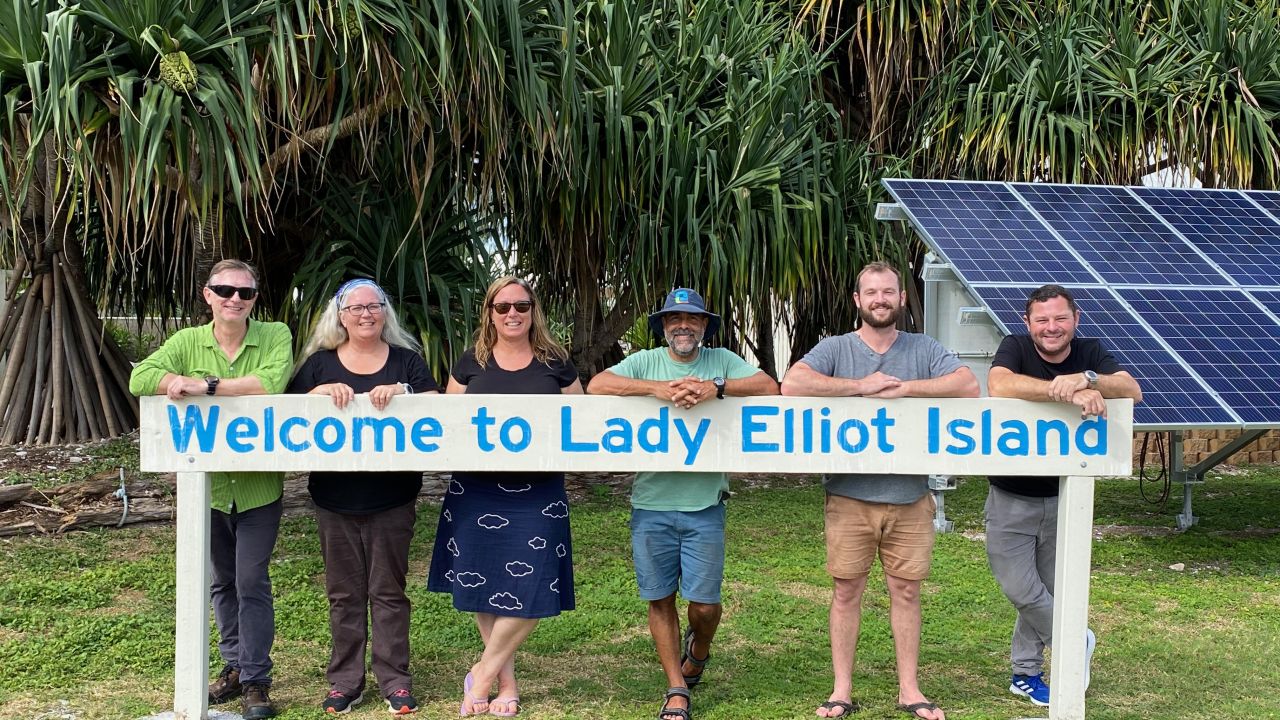Project News ·
Leaf to Reef team back on Lady Elliot
The Leaf to Reef team is preparing for their third trip to Lady Elliot Island this month, to further understand the island’s response to climate change.

As part of the Reef Island Initiative, the Leaf to Reef team conducts periodic research on Lady Elliot Island to provide insights into some of the ecosystems of the Great Barrier Reef. The team of researchers from the University of the Sunshine Coast, the University of Queensland and Southern Cross University use a resilience approach to safe-guard the island’s land and marine environment from the effects of climate change.
The team’s successful trip in June 2021 added to the island’s biodiversity database, where 400 vertebrate species were catalogued and 120 images of manta rays were photo identified, with some manta rays being tagged for tracking.

Mantra ray at Lady Elliot Island tagged by Leaf to Reef research team as part of Reef Islands Initiative.
Water table mapping enhanced understanding of the marine environment of Lady Elliot Island and its health. Specialist equipment mapped the size of the freshwater environment, locations nutrients enter the Reef, and where saltwater is infiltrating the freshwater environment.

Leaf to Reef groundwater team using Loupe EM transient electromagnetic induction to map the island’s water table. Credit: Leaf to Reef
The use of stereoscopic cameras surveyed and mapped the reef environment of the island using GPS location technology.

Stereoscopic camera setup on Lady Elliot Island's reef. Credit: Leaf to Reef
Since 2018 the Leaf to Reef team also have:
- Identified six breeding pairs of the endangered Red-Tailed Tropic Birds (RTTB) in one season, and discovered the oldest known nesting RTTB.
- Tagged 20 juvenile Green Turtles and three Hawksbill Turtles to better understand the region’s turtle population.
- Sampled 60+ Silvereye birds for genetic analysis to examine the island’s connectivity with other ecosystems.
- Verified 14 bird species as occurring on LEI, increasing the list from 85 to 99
- Photo-identified 100+ manta rays, tagged 12 and sighted resident manta ray Taurus, a 50+ year-old manta ray and the oldest recorded in the world.

A dolphin 'fly by' captured by researchers in the Leaf to Reef team. Credit: Leaf to Reef
This research helps inform the Reef Island Initiative, where on-ground and in-water actions help restore LEI and allow the island to adapt to climate change.
Since 2018, the Reef Island Initiative has undertaken the following restoration and adaptation projects:
- Revegetated 11 hectares by clearing weeds and planting 7,310+ coral cay native trees, shrubs, vines, groundcovers and grasses.
- Stocked 7,000 plants of 27 species in the only native coral cay species’ nursery on a Great Barrier Reef island.
- Increased turtle habitat by 125% on the island's main nesting beach.
- Developed successful methodologies for propagating native grasses for use in revegetation.
#The case of Whoopi Old Bird
Discovered on Lady Elliot Island, Whoopi Old Bird was found to be the oldest known nesting Red-tailed Tropic Bird at 23 years of age. He was tagged as a chick back in 1997 and was rediscovered nesting with another bird last year, but without genetic analysis the gender of the birds was unknown. This year the Leaf to Reef team managed to photograph Whoopi’s partner laying an egg, confirming he is the male of the pair with his partner coined as ‘Anna Nicole Smith’.

Red-tailed tropic bird nicknamed Whoopi Old Bird found nesting on Lady Elliot Island, the oldest breeding RTTB on record. Credit: Christine Dudgeon from Leaf to Reef
#What's Next?
Right now, the team is preparing for their next trip to Lady Elliot Island in the coming weeks. Red-tailed tropic bird movement will be tracked further, with satellite tags to be deployed on two birds from different nests.
The team will continue with their sea turtle analysis from last year’s trip, catching juvenile green and hawksbill turtles to obtain samples for toxicology and genetic analysis.
An expert from CSIRO will also be joining the team to help identify plankton on the Reef. This is to describe the plankton community around the island and examine their distribution, a crucial organism for the Reef’s food chain.
#Related

Project News ·
Community at the forefront of Reef water quality protection

Project News ·


